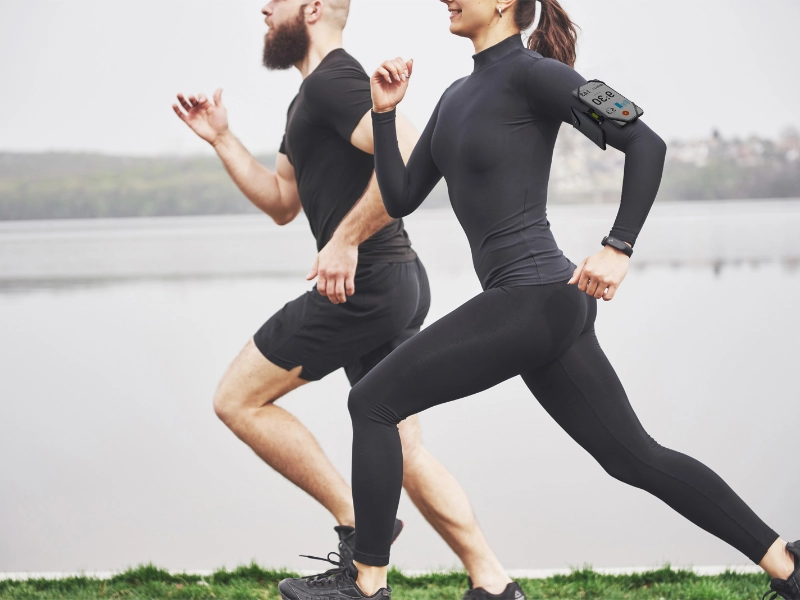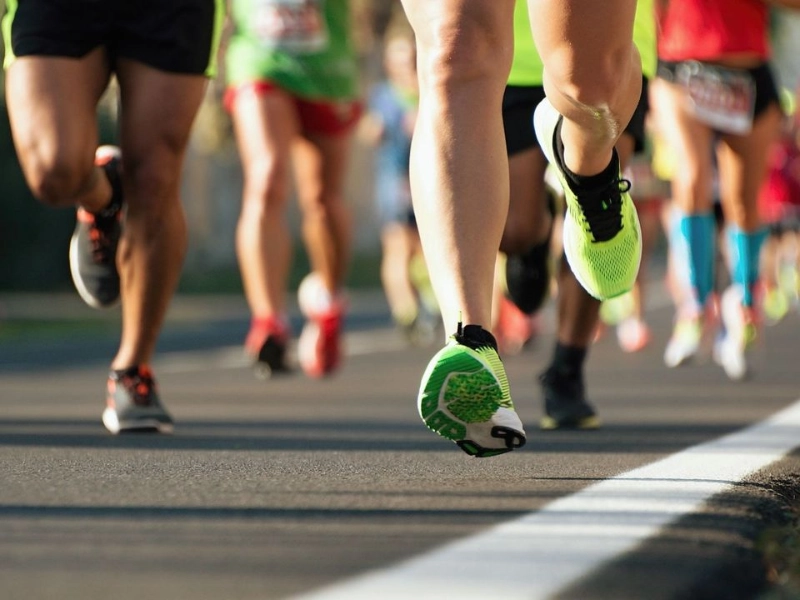Using good form when running reduces the chance of injury and improves your running efficiency; you'll also use less energy. Common running mistakes include crossing the center line with each stride or leaning too far forward from the hips, both of which create braking forces that disrupt your momentum. Improving your running form takes patience and some small adjustments to your stride length, posture, and body position.

 Running inevitably involves bouncing, but bouncing can be minimized by strengthening your core and developing a proper knee drive. Taking shorter strides and a more relaxed rhythm can also help reduce symptoms.
When jogging, it can be helpful to keep your arms close to your body to prevent over-movement. This position allows you to move forward and backward with the same energy, resulting in less wasted motion. Some
runners advocate for heel striking, while others prefer to strike with the midfoot or forefoot. Ultimately, it's important to find a form that's comfortable for you; doing so will reduce the chance of injury and make running more enjoyable.
Running inevitably involves bouncing, but bouncing can be minimized by strengthening your core and developing a proper knee drive. Taking shorter strides and a more relaxed rhythm can also help reduce symptoms.
When jogging, it can be helpful to keep your arms close to your body to prevent over-movement. This position allows you to move forward and backward with the same energy, resulting in less wasted motion. Some
runners advocate for heel striking, while others prefer to strike with the midfoot or forefoot. Ultimately, it's important to find a form that's comfortable for you; doing so will reduce the chance of injury and make running more enjoyable.
 When you run, keeping your feet aligned will help prevent heel strikes and toes from rolling off the ground. When your feet hit the ground before your torso, it takes more effort to push off the ground. This is known as heel strike. If your feet are not in the same centerline, your toes will tilt out, which can lead to injury and increased fatigue. It
may be hard to correct, but these errors must be addressed if you want to improve your running form. Focusing on the 5 key elements of running will help you run faster and more effectively. In the end, that equates to less suffering and more fun.
When you run, keeping your feet aligned will help prevent heel strikes and toes from rolling off the ground. When your feet hit the ground before your torso, it takes more effort to push off the ground. This is known as heel strike. If your feet are not in the same centerline, your toes will tilt out, which can lead to injury and increased fatigue. It
may be hard to correct, but these errors must be addressed if you want to improve your running form. Focusing on the 5 key elements of running will help you run faster and more effectively. In the end, that equates to less suffering and more fun.
 Many people swing their arms too far forward when they run. This is ineffective and puts undue strain on your hips and shoulders, which can lead to injury. Instead, strive to keep your hands close to your body while running. The best way to visualize
this is to draw a line down the middle of your body from your chin to your belly button. This is where you should not cross. Instead of swinging across this line, your arms should swing towards it.
Additionally, your elbows should not lightly touch your rib cage. This will reduce the chances of injury and help you maintain proper form.
Many people swing their arms too far forward when they run. This is ineffective and puts undue strain on your hips and shoulders, which can lead to injury. Instead, strive to keep your hands close to your body while running. The best way to visualize
this is to draw a line down the middle of your body from your chin to your belly button. This is where you should not cross. Instead of swinging across this line, your arms should swing towards it.
Additionally, your elbows should not lightly touch your rib cage. This will reduce the chances of injury and help you maintain proper form.
 Some runners tend to slouch from their shoulders or hips as they tire. This restricts ventilation and makes it difficult to maintain proper form. Instead of clenching your fists or rushing with force, try running with your shoulders back and your chest high. Keeping your arms close to your
body and your legs together also helps you avoid the classic over-stride error of falling over your heels with every step, which can cause discomfort and injury. A higher cadence also improves efficiency and reduces strain on your ankles, knees, and hips.
If you're having trouble with your running form, try gradually incorporating these small adjustments into your routine. It's a good idea to consult with a coach or physical therapist before making any major changes to your running routine.
Some runners tend to slouch from their shoulders or hips as they tire. This restricts ventilation and makes it difficult to maintain proper form. Instead of clenching your fists or rushing with force, try running with your shoulders back and your chest high. Keeping your arms close to your
body and your legs together also helps you avoid the classic over-stride error of falling over your heels with every step, which can cause discomfort and injury. A higher cadence also improves efficiency and reduces strain on your ankles, knees, and hips.
If you're having trouble with your running form, try gradually incorporating these small adjustments into your routine. It's a good idea to consult with a coach or physical therapist before making any major changes to your running routine.
 It's important to remember that good running form takes time to develop. Adjusting your running form over time will help you see visible improvements and reduce your chances of injury.
For example, increasing your stride rate and cadence will make you a more efficient runner. A higher cadence will keep your foot moving under you instead of in front of you, reducing over-striding, a leading cause of running injuries.
Core strength and stability will help you stay upright and stable with less bouncing and other unnecessary movements. Strong and healthy muscles will help you run faster and longer.
It's important to remember that good running form takes time to develop. Adjusting your running form over time will help you see visible improvements and reduce your chances of injury.
For example, increasing your stride rate and cadence will make you a more efficient runner. A higher cadence will keep your foot moving under you instead of in front of you, reducing over-striding, a leading cause of running injuries.
Core strength and stability will help you stay upright and stable with less bouncing and other unnecessary movements. Strong and healthy muscles will help you run faster and longer.